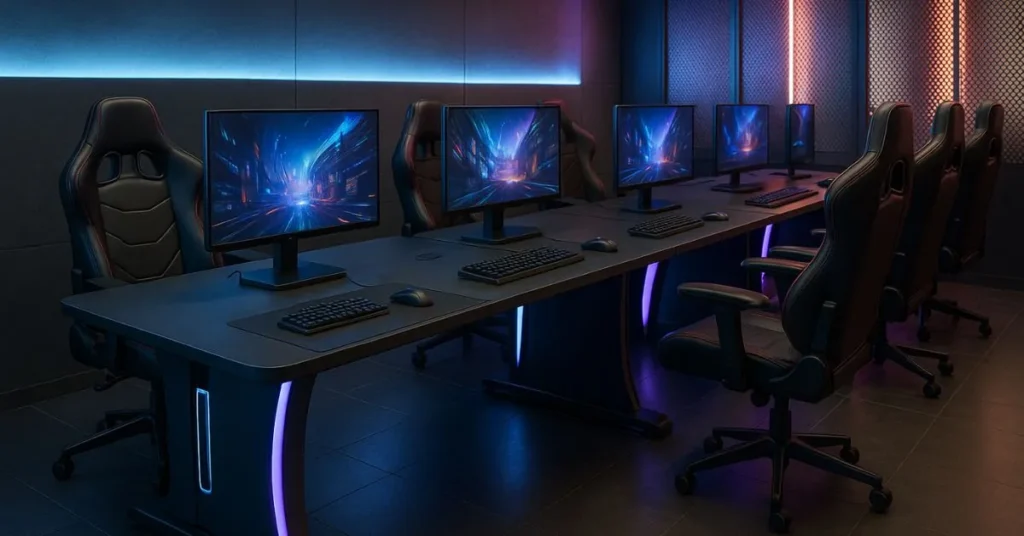Gaming cafés and esports lounges are no longer just places to grab a computer and play a few rounds with friends. They have become hubs of social activity, competitive training grounds, and stylish destinations where design plays a decisive role in shaping the player experience. As esports and streaming culture continue to expand globally, the demand for more visually appealing environments has increased significantly.
One of the most significant shifts has been the attention paid to ergonomics. Players are no longer satisfied with standard furniture, which leads to discomfort and fatigue after just a few hours. Ergonomically designed tables, even quality commercial restaurant tables, are now recognized as an essential component of the setup, supporting comfort, proper posture, and long-term health. Recent statistics reveal that sales of ergonomic gaming chairs have increased by more than 20 percent in just two years, while sales of multi-functional gaming desks are growing at an annual rate of nearly 18 percent.
Approximately 35 percent of gamers report experiencing physical discomfort during extended gaming sessions, and nearly half say they prioritize ergonomic furniture. With the global gaming desk market valued at almost $200 million in 2021 and projected to grow by about 10 percent annually until 2028, it is clear that furniture is not just an accessory; it is integral to the gaming performance equation.
Contents
The Core of Ergonomic Design in Gaming Tables
The foundation of a strong gaming setup begins with the right table. Adjustable height functions have become a standard feature in high-quality ergonomic furniture designs, not just in ergonomic gamepads, enabling players of all body types to find a comfortable position. Small details, such as rounded corners and wrist rests, make a big difference during long play sessions, keeping strain and discomfort at bay.
Clutter is another hidden enemy of focus. Built-in cable management systems provide players with a clean surface and eliminate distractions. To meet the demands of busy gaming cafés, manufacturers now use materials that are both light and durable, making them easy to move yet strong enough to withstand daily use. Modular sections add another layer of flexibility, allowing for quick shifts between individual play and team-based configurations. Surfaces treated to resist glare and smudges are also becoming common, ensuring clear visibility of monitors and easy maintenance in high-traffic venues.
Technology Meets Functionality
Modern gamers expect more than a flat surface. The tables of today are equipped with technology that keeps them in the game without interruptions. Built-in charging stations, from traditional USB ports to wireless pads, allow devices to stay powered throughout the day. Some designs include RGB lighting and underglow effects that sync with games or display team branding, adding atmosphere and energy to the space.
Keeping equipment cool is also important. Ventilated sections or active cooling designs prevent overheating in laptops and PCs, while integrated USB and HDMI hubs make it easier for streamers to plug in their gear without needing extra adapters. In louder cafés, sound-dampening features in the materials can lower noise levels, improving the experience for both players and spectators. The most advanced designs even include proximity sensors, which can adjust lighting or activate presets when a player sits down at a reserved station.
Aesthetic Appeal and Branding Opportunities
Gaming tables are more than just tools; they are also an integral part of the décor. They serve as visual centerpieces in cafés and esports lounges, reinforcing the venue’s identity. Custom finishes, branded logos, and LED underglow create powerful opportunities to highlight a café’s style.
Consistency in design also matters. Color-coded setups that match team colors or café branding can tie the space together. Sleek futuristic looks help elevate the atmosphere of a lounge, while practical details ensure that players still get everyday usability. Many venues are also turning to sustainable materials, such as recycled metals or responsibly sourced wood, to appeal to environmentally conscious gamers. For those looking to stand out, themed designs can transform zones within a café into immersive spaces, whether inspired by sci-fi, retro arcades, or fantasy worlds.
Health and Performance Benefits for Gamers
The benefits of ergonomic tables extend far beyond their appearance. By supporting proper posture, they reduce the risk of long-term health issues such as back, neck, and wrist strain. For players, the difference is evident in their focus and performance. A well-organized table surface helps reduce cognitive load, allowing gamers to concentrate fully on the match.
Studies show that professional players who use ergonomic setups experience less muscle stiffness and even achieve measurable improvements in results. Trials have reported increases of 15 percent in kills and 25 percent more wins when players used ergonomically designed furniture. The long-term comfort also means players can enjoy longer sessions, which is valuable for venues that thrive on repeat customers. Gaming can involve repetitive movements at levels that exceed those of traditional office work, making ergonomic design essential for reducing the risk of injuries. For cafés and lounges, these features convey a clear message that they prioritize player well-being, which fosters loyalty and encourages extended stays.
Business Advantages for Gaming Cafés and Lounges
From a business perspective, ergonomic tables offer both practical and marketing advantages. They serve as premium features that attract serious gamers and content creators seeking professional-quality setups. In a crowded market, this can help a café stand out from its competitors. Positive experiences often translate into strong reviews and recommendations, particularly among younger, health-conscious customers who value wellness in all areas of their lives.
Revenue benefits follow naturally. Comfortable setups encourage more extended visits, which typically lead to higher food and beverage sales. While ergonomic tables may cost more upfront, their durability and the branding value they provide often deliver excellent returns over cheaper, less reliable options. Some venues even use ergonomic setups to introduce tiered seating models or premium zones for players willing to pay more for comfort and performance.
Setting the Standard for Social Gaming Ergonomics
The rise of ergonomic tables marks an essential shift in how gaming spaces are designed. These tables form the foundation for immersive and comfortable environments that benefit players, business owners, and communities alike. Good design not only enhances individual performance but also shapes culture and creates spaces where gamers want to spend their time.
Venues that adopt ergonomic furniture early are setting themselves apart as leaders in the industry, showing commitment to both style and player well-being. By investing in comfort and technology, café owners can secure long-term loyalty and maintain a competitive edge. The future of gaming lounges is being built today, and it is a future defined by tables that merge design, wellness, and innovation into a single unforgettable experience.

